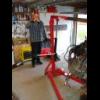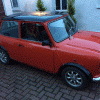What Is The Best Primer?
#1

Posted 25 May 2020 - 11:27 AM
What is the best primer used for the engine bay. I’ve stripped it back to bare metal, so etch primer first, then what is the best primer used for the top coat?
Thanks
Will
#2

Posted 25 May 2020 - 11:32 AM
Epoxy primer
#3

Posted 25 May 2020 - 02:42 PM
#4

Posted 25 May 2020 - 10:55 PM
Thanks
#5

Posted 26 May 2020 - 12:30 AM
With respect if you're "new to this" then stay well clear of 2k paint in general as it can make you very ill indeed or even kill you, so not good.
Google it to see why and how to safely spray it if you insist on using 2k.
The good news is that epoxy primer is available in non 2k, 1k if you like, in spray cans if you don't have a compressor/spray gun set up, its not as tough as 2k but is perfectly acceptable to use. It still chemicals though and stinks so a decent mask and ventilation is still necessary but you don't need a full air fed mask like 2k
As for epoxy primer brands I've used Novol 2k before and its good stuff so hopeful their 1k stuff will be good too, but I haven't used it personally, you can get it on ebay for around £13 a can, think its official title is Spectral 395 epoxy primer, remember its the epoxy primer bit you need to remember as they do acrylic primer as well.
Have a look on here it might help you out a bit http://www.theminifo...p-and-re-spray/
Edited by Furyan, 26 May 2020 - 12:48 AM.
#6

Posted 02 June 2020 - 04:24 PM
https://www.eastwood...gray-black.html
I'm going to be trying it out soon before applying undercoating soon.
#7

Posted 02 June 2020 - 05:07 PM
I know i mentioned epoxy earlier but all of my car has been primed in Octoral PF131 Surfacer which is a recommendation from Ben_O. And i have to say its good stuff.
Self etching and a filler primer in one. Its not cheap.
So you can buy 1K Epoxy primer and i have been using Novol products while i was restoring my car to keep corrosion at bay.
https://www.ebay.co....l-/162451989542
#8

Posted 11 June 2020 - 03:53 AM
#9

Posted 11 June 2020 - 07:39 AM
Check the data sheets as 2K is a bit of a misunderstood and used term, all it actually means is that two items are mixed together to form the final product.
When we talk about 2K paint we generally mean paint with isocyanate content which is extremely hazardous if you don't use the correct breathing equipment, 2K epoxy primer isn't necessarily the same and the stuff I've been using has no isocyanate in it.
The most important thing is to read the safety data sheet for the products you are looking to use and follow the manufacturers requirements for protective equipment.
#10

Posted 12 June 2020 - 12:39 PM
Would I be better doing Epoxy primer then Seam sealer?
Trying to work out if I epoxy prime before closing in sills etc.
Thanks.
#11

Posted 12 June 2020 - 12:41 PM
#12

Posted 13 June 2020 - 08:41 AM
Just out of interest, as I am working through my repairs bit by bit, I am tending to spray with acrylic red oxide straight after welding. Once completely repaired, i.e the whole of the underneath, would I then need to strip back to then spray again with epoxy? The whole repair is going to take some time, so obviously do not want to leave weld exposed for any amount of time.
#13

Posted 14 June 2020 - 12:50 AM
1) I would use epoxy primer instead of weld-through primer in as many places as possible. The only place I can think of where I wouldn't is the backside of a weld area that I can not get to after the welding is done. Then the weld-through may be better since presumably it doesn't burn off after the weld is done. Because of epoxy's resistance to moisture pentration, it would be ideal for the insides of sills and other to-be-closed sections, other than having to watch for weld areas. For those seams, an additional coating like Eastwood Internal Frame Coating followed by regular treatments of a good anti-corrosive treatment like Waxoyl/Dinitrol, etc will likely keep them sound for the life of the car.
2) It will be time consuming, but I'd strip off the acrylic primer and re-prime with epoxy as soon as time allows. Not only can an acrylic 1-step (1K) primer be penetrated by moisture, it is not nearly as resistant to stones and chipping, not to mention chemicals. I'd preferably either prime with epoxy instead, or, if you don't want to strip and re-prime, use a good etching 2K primer (primer and catalyst.) This will also be a big step ahead of 1K primer, especially in a chip and moisture-prone area like the underside, if you only want to spray base primer once.
Dave
#14

Posted 14 June 2020 - 03:02 PM
Thanks Dave. So, as I have not got too far yet, it may be as well to get some spray epoxy primer to spray the panels once repaired and then when all done coat again? Would this make sense?
#15

Posted 14 June 2020 - 10:52 PM
If you spray a proper coating of epoxy, you don't have to recoat it again later when you apply your next topcoats (be it surfacing primer or paint.) One good coat is all that is needed. After the epoxy cures (usually between 24 hours and a week depending on the manufacturer) you'll have to scuff it down before applying any other coat on top, but that's normal for any and all products of any type.
There is one advantage to respraying with more epoxy, though on places like the underside it may not be worth the effort and materials to do so. Before the epoxy fully cures, it is capable of bonding chemically to another 2K product applied over it (like 2K surfacing primer or 2K paint.) This is above and beyond the normal mechanical bond. In fact, if the epoxy hasn't cured, in most cases you don't even have to scuff it down before applying another 2K product (check your directions to be certain.)
So if you're able to schedule this all out, you can save some time by applying epoxy, then applying the next topcoat in succession. No need to scuff, and a better chemical bond. If the epoxy has cured, you can scuff it down, apply more epoxy, then apply the next topcoat. That can be overkill IMHO in most cases though. I'll do it when I get a chance and try to plan it out so I can, but I don't fret if I can't get to the next topcoat in time and rely only on scuffing for mechanical adhesion.
One more positive for the epoxy - if you find you need to apply more plastic filler after you spray the epoxy (before it cures) you can apply the filler directly on top of the epoxy - no need to strip it down to bare metal. I and many others actually never apply filler to bare metal and always apply it after an epoxy coat. The epoxy will chemically bond to the filler and grip it more strongly than bare metal will. And the epoxy seals the metal against moisture which plastic fillers absorb. Always coat the filler with more epoxy primer to seal it against moisture.
Dave
0 user(s) are reading this topic
0 members, 0 guests, 0 anonymous users
















